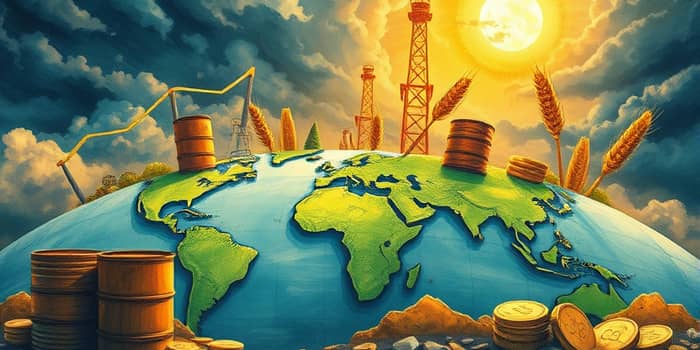
In a world still adjusting to post-pandemic realities and shifting global dynamics, commodity prices have entered a period of pronounced volatility. Forecasts point to a 7% decline in average prices for 2025 and again in 2026, yet commodity prices remain 23% above 2019 levels in 2025. Understanding the forces behind these shifts is crucial for investors, businesses, and consumers alike.
The interplay of economic, geopolitical, and climatic factors forms the backbone of commodity price movements. At the forefront is weak global economic growth weighing on demand.
Despite an anticipated price decline, the baseline remains elevated compared with pre-pandemic levels. This resilience underscores persistent supply constraints and strategic stockpiling in anticipation of future shocks.
In the energy sector, crude oil and natural gas display divergent trends shaped by supply gluts and emerging demand sources. Brent crude is projected to average between $68 and $74 per barrel in 2025, slipping to $60–$66 per barrel in 2026. These forecasts reflect consensus on global oil production growing faster than demand.
Meanwhile, natural gas is positioned for a boom year in 2025. The rapid expansion of AI and data centers is fueling electricity consumption, creating robust support for gas prices even as renewable capacity grows.
Copper remains a bellwether for both industrial health and the global energy transition. Prices are forecast to average $9,000 per ton in the first half of 2025, with potential to exceed $10,000 per ton by late 2026. However, an aggressive trade war scenario could push averages down to $8,000 per ton.
Global steel demand outside of China shows tentative signs of improvement, but weak overall consumption continues to keep prices under pressure.
Within the agricultural sphere, grain and oilseed markets are experiencing nuanced shifts rather than dramatic swings. Wheat markets are tightening but hold enough stocks to prevent price spikes seen from 2021–2023. Corn prices are expected to rise modestly, with high stocks-to-use ratios tempering gains.
Soybean prices face headwinds from record production paired with ongoing trade tensions, though stabilization is forecast in 2026. Rice continues its decline after India lifted export restrictions, and fertilizer costs are set to surge 21% in 2025 before easing in 2026.
Food indices tell a broader story. World Bank data projects a 6.1% drop in global food prices in 2025, while US consumers may see a 3.0% increase on average, driven by inflationary pressures in meat and dairy. Fresh vegetables are likely to remain at current price levels.
Precious metals are poised for robust gains as investors seek refuge from market uncertainty. Gold prices are forecast to climb 42% in 2025 and a further 5% in 2026, supported by safe-haven demand and central bank purchases. Trading Economics sees gold reaching $4,209.31 per ounce in 2025.
Silver follows suit with a projected 34% rise in 2025 and 8% in 2026, reflecting both its role as a haven asset and its industrial applications in electronics and solar panels.
Multiple cross-currents converge to shape commodity trajectories. Geopolitical tensions, particularly US-China trade disputes, threaten to further depress metals prices. On the other hand, sanctions or conflicts could send oil and safe-haven metals sharply higher.
Monetary policy also plays a decisive role. Central banks in advanced economies are cutting rates, which may bolster capital-intensive sectors and commodity demand later in 2025. Yet inflation remains a wild card, especially for energy and food.
Climate-related factors are equally influential. Extreme weather events such as La Niña can disrupt crop yields and boost electricity demand, while long-term climate shifts heighten the unpredictability of agricultural output and energy needs.
To synthesize the outlook across major commodity classes, the table below highlights 2025 and 2026 price forecasts alongside the primary drivers for each commodity.
While commodity prices are poised for declines in 2025 and 2026, they will remain above historical norms, reflecting enduring structural constraints and strategic considerations. Market participants must balance the bearish signals from weak growth and ample supply with the bull case offered by geopolitical risks, central bank policies, and the accelerating transition to clean energy.
By keeping a close watch on evolving demand drivers—such as AI-driven power consumption, electric vehicle adoption, and climate-induced disruptions—stakeholders can better position themselves to weather volatility and capitalize on emerging opportunities.
Ultimately, the commodity market’s rough seas require both caution and flexibility. Armed with data-driven insights and a nuanced understanding of the forces at work, investors and businesses can chart a course through uncertainty toward sustainable growth.
References





